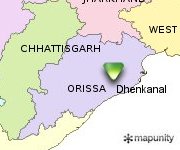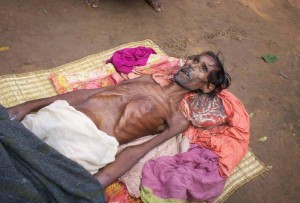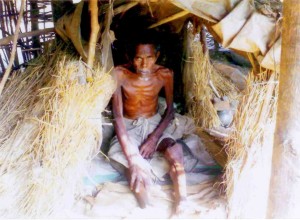Last November, Santara Naik, a resident of Dhirapatna village of Dhenkanal district in Orissa, died of starvation. Today, his wife Sajani lives in their half-broken, neat but empty dwelling, with their two daughters and a grandson. There's no need to ask her questions about the reasons behind Naik's death. Her appearance conveys more than words could ever do - she herself is nothing more than a bundle of bones.

![]() Sajani traces his death to Orissa government's 1998 ban on using bamboo from forests. The ban came because of the increased commercial importance of non-timber forest produce, kendu leaf, sal seed, and bamboo, all of which were nationalised in Orissa, thereby entailing only the state to collect and market these products. (Sal was nationalised in 1983 and kendu leaf in 1973.)
Sajani traces his death to Orissa government's 1998 ban on using bamboo from forests. The ban came because of the increased commercial importance of non-timber forest produce, kendu leaf, sal seed, and bamboo, all of which were nationalised in Orissa, thereby entailing only the state to collect and market these products. (Sal was nationalised in 1983 and kendu leaf in 1973.)
Naik had made his living till then by collecting bamboo from forests, weaving baskets and selling them at the village market. However, after the ban, he couldn't collect bamboo and didn't have the financial resources to buy it from the market. He had no other skills and could not find an alternative source of livelihood. As he had no experience in agricultural work, and as he belonged to a Scheduled Caste, villagers did not call him for agricultural labour. In the last years of his life, Naik, an artisan, was reduced to soliciting food from villagers.

![]() Santara Naik
Santara Naik
Now, almost nine months after his death, his 50-year-old wife and his daughters, aged 28 and 15, haven't found any employment either. Villagers do not enlist their services for the same reasons they avoided Naik. Compounding the problem is their low body weight and high malnutrition levels, which make it impossible for them to do any labour-intensive work.
By no account is Naik's story a unique one in Orissa, where hunger and starvation persist scandalously. Because of a number of problems, ranging from livelihood crisis and indebtedness to distress migration, prolonged malnutrition and non-implementation of government schemes, starvation amongst the state's population is not at all uncommon. Even the consumption of inedible items such as mango kernels, poisonous roots and tubers and similar so-called 'distress food' items - often passed off as 'traditional tribal food' - indicate the existence of high levels of hunger and starvation in the state.
There are no concrete figures for the number of starvation cases in Orissa, as the government itself has so far not acknowledged that there is a problem. It was only because of sustained pressure from the media, the judiciary, the National Human Rights Commission and citizen's groups that the Orissa government released what is considered as an underestimated figure of instances of starvation deaths in the state. Koshala Development Forum, an organisation that undertakes research on under-development in Orissa's tribal-dominated Koshala region, cites in its working paper no.1, 2004, a written statement by revenue minister Biswabhusan Harichandan about starvation deaths presented in the State Assembly, published in Utkal Sambad, an Oriya daily. From 2000 to 2003, 441 starvation deaths were reported in the state, the minister said. Of these, 268 deaths were from the southern region, which has a high tribal population.
Defining starvation
The Orissa government thus far seems to have relied on a narrow definition of starvation to refute reports of starvation deaths. And it's true that not many people die exclusively because of starvation. Starvation weakens the body and the person eventually succumbs to a disease, due to his or her severely compromised immunity. Take the case of Nakula Naik, a 45-year-old from Mangalpur village in Dhenkanal district, who died of starvation in February this year. A Dom by caste, he too was a bamboo weaver like Santara Naik, and faced problems in procuring bamboo. In addition, he developed asthma and therefore could not do manual labour. Gradually, the family had to live on mendicancy and face acute starvation. Although the sarpanch helped him get admission in a hospital, he was released before his full recovery as he did not have the money to continue treatment. The family lived by consuming 'distress-food' items such as wild leaves and tubers. After his death, his wife and his one-year-old child continue to be threatened by starvation. A half-broken dwelling and a few vessels are their only worldly possessions.
Though in normal circumstances, a disease like asthma may not be fatal, a person who is starving is unable to combat it. However, disease, and not starvation, is given as the official reason for death. Moreover, public officials tend to believe that starvation means absolutely no intake of food. Therefore, if the post-mortem reveals a few grains in the stomach of the deceased, starvation reports are rubbished.
Chaman Lal, Special Rappoteur of the National Human Rights Commission, is quoted as saying in activist Harsh Mander's book Towards a Food Rights Code, "A person does not have to die to prove that he is starving. This insistence on death as a proof to starvation must be given up. Continuance of a distress situation is enough proof that a person is starving." The Hunger Watch Group also affirmed that starvation is a public heath issue, as mortality occurs even in case of diseases that are not ordinarily life-threatening. As Hunger Watch's guidelines state, individual malnutrition deaths are often extreme examples of severe malnutrition prevalent in a community. Therefore, it calls for a community diagnosis.
A public heath issue
Apart from livelihood issues and resultant poverty, one major reason why starving people succumb to disease in Orissa is the lack of access to modern-day healthcare. Starvation deaths, which are reported from the Similipal national park in Orissa almost every year, confirm this. A report by ActionAid Orissa, dated June 2006, notes that there had been 18 reports of children's deaths in the first five months of that year. In 2005, 23 people had died, 13 of who were children. The report also noted that inaccessible and unaffordable healthcare facilities were a major cause of child starvation deaths. In Simplipal, the nearest hospital is located 23 km from the gram panchayat headquarters, and even further for remote villages. The ambulance provided by the district health unit charges Rs 5 per km to transport patients to the government-run Jasipur Hospital, which is the closest. Most people are not able to afford the fare, and therefore, the sick have to walk or be taken on a cycle.
The report quotes Purnami, a resident of Gudugudia village in Simlipal district, as saying, "I took my son Mantu to hospital once by ambulance but cannot pay the amount a second time although my son is still suffering." Purnami lost her husband due to malaria soon after marriage, and is now struggling to save her five-year-old son and seven-year-old daughter, who are severely sick and malnourished. Kumati Dehury, also from Gudugadia, has a six-year-old child who's suffering from malnutrition and often gets fever. She cries as she describes how difficult it's for them to get any attention from doctors who treat them with little dignity at the hospital. The report notes that as agriculture is underdeveloped in the village, most residents make a living by picking minor forest produce and selling timber and firewood.
Though basic healthcare is subsidised or free on paper, corruption is said to prevail at government hospitals. In addition, indirect expenses such as transport and food costs, and loss of wages, result in healthcare becoming unaffordable to the poor. The significant amounts that they are forced to spend on healthcare often lead them into a heavy debt trap. "Simlipal's villages, which are inhabited by tribal communities, are thus forced to resort to quacks. Locked inside their leafy green jail, they are dying of disease and apathy," says the ActionAid investigation report.
Failure of government schemes
On February 16, 2008, Pratap Barala, a reporter with local newspaper Pragatibadi, wrote about the plight of a blind, 70-year-old man in Dhenkanal. Development Initiative, a human rights organisation in Orissa, investigated this case. Bimbadhar Pradhan, the old man, lives with a widowed daughter-in-law, a teenage granddaughter and a polio-affected grandson. No one in his family is able to earn except his granddaughter. Despite her daily toil, her earnings are not enough to support the family of four. Their Antyodaya card lies unused as they have no money to buy grains even at the highly subsidised rates.

![]() Dhoba Dehury
Dhoba Dehury
In the same village lives Dhoba Dehury, a Sabara tribal, who saw his sons and wife die of disease caused by malnutrition. Despite frantic attempts, he could not gather enough money to save his family. He earned a little through casual, daily wage labour, barely enough even to survive, but is today old and destitute, and completely dependent on his brother-in-law, who himself is living on the edge. Weakened and malnourished, Dehury has lost his strength to walk. Without even a homestead land, he sleeps in the brother-in-law's cattleshed and has only straw to cover himself, even in winters. The only help Dehury has received from the government is a Below Poverty Line ration card. However, he cannot draw any ration as he has no cash to pay for it. Despite the scheme's universalisation, he is not yet covered under the old-age pension plan.
Development Initiative's fact-finding team had two important conclusions to make: Dehury is starving and if timely help is not provided by the district administration, he is going to be a victim of starvation. The team's report, dated March 2008, was submitted to the National Commission of Scheduled Castes.
People living in villages of Simlipal national park travel 13 km to Gudugudia gram panchayat headquarters to get their rice, kerosene oil and sugar, under the Public Distribution System schemes, either every month or once in two months. Though many have Antodaya cards, they receive only 25 kilos of rice as against the entitlement of 35 kilos. This happens almost all the time, according to the ActionAid report.
The report says that the villagers own small plots of land, which provide a major share of the food that they consume. However, due to mono-cropping, the produce lasts only for 4-5 months. For the rest of the year, they depend on minor forest products, which are difficult to access. Their other source of livelihood should ideally have been employment under government programmes, but these are only occasionally available. According to the ActionAid report, in 2006, not a single day of employment had been generated under the National Rural Employment Guarantee Scheme (NREGS) till June of that year.
When death doesn't mean an end to trouble
Santara Naik of Dhenkanal died in November 2007 of starvation despite having a BPL card and a job card under NREGS. He couldn't purchase grains because he didn't have an income, and he was never given employment. Naik even reported to the sarpanch and the ward member that he was starving. They gave him Rs 50 to travel to meet the district collector, who in turn sent him to the Block Development Officer (BDO). The BDO was indifferent and offered no immediate help. The sarpanch gave him 10 kilos of rice twice, but after that got over, his family had to live on wild food items. When Naik became too ill to move, government officials didn't take note of the situation, despite repeated complaints from his wife. The family was occasionally given some rice obtained as part of the mid-day meal programme at the village school, but this wasn't regular.
To date, Naik's family has not been given an Antodaya card. On their BPL card, they get only 10 kilos of rice against a quota of 25 kilos and they purchase it with the Rs 200 they are given under the old age pension scheme. However, the grains last only for 10 days a month and they have to depend on mendicancy for the rest of the month. The money given as family benefit is over now and again, the family sleeps hungry for many a days. The daughter, Jhunu Naik, says," How long can we continue to beg and eat, we too will die of starvation someday." Even after Naik's death, neither his wife nor his daughters are being given work under NREGS.
The villagers of Dhirapatna have sought an investigation into Santara Naik's death. They have written applications to Prime Minister Manmohan Singh, the Prime Minister, Congress President Sonia Gandhi, and to Dhenkanal district collector Jamil Ahmed Khan. Lawyers from Development Initiative also appealed to the National Commission for the Scheduled Castes, and presented to them their investigation reports, including the one concerning Dehury.
When the commission sought an explanation from the district authorities, the collector's report accused the NGO of "fake reporting and total misrepresentation of facts". It alleged that Naik's death was due to "old age and prolonged illness". The collector's report put Santara Naik's age at 70 though his voter identity card says he is 61. His family reports no disease prior to death.
Similarly, Nakula Naik's family was provided an Antodaya card after his death, but is getting only 10 kilos of rice on it. His wife continues to live in their broken house, where an old saree serves as the ceiling. The collector gave the family Rs 300 as funeral expenses while the sarpanch gave Rs 100. The ration dealer gave them 10 kilos of rice, two litres of kerosene and 2.5 kilos of pulses. Officials claim that they had given the family Rs 5,000 for medical treatment but the family denies this.
As far as Dehury is concerned, the collector's office claims that he is not starving as he has an Antodaya card and a house sanctioned in his name under the Indira Awas Yojana. However, Dehury's card is used by his brother-in-law as Dehury himself doesn't have money to buy even at the subsidised rate of Rs.105 for 35 kilos of rice. Even the house purportedly given to him isn't actually his as he cannot pay the Rs.8000 that has to be given to the sarpanch to get the house registered in his name. Pradhan, and several others in Orissa, suffer the same fate.
























